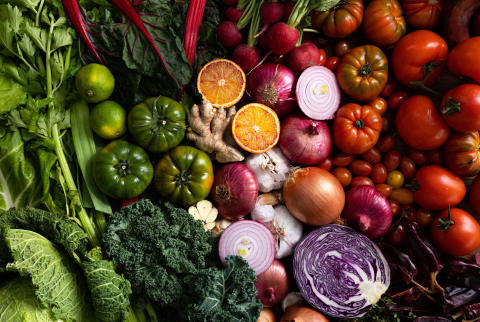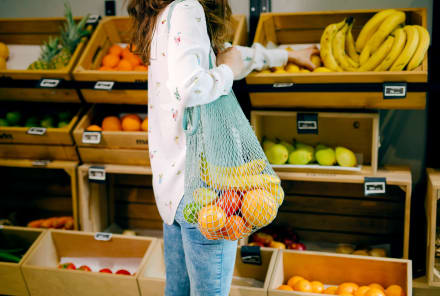Advertisement
I Tried Eating 30+ Different Plants Each Week For A Month — Here's How It Went

Hannah Frye is the Assistant Beauty Editor at mindbodygreen. She has a B.S. in journalism and a minor in women’s, gender, and queer studies from California Polytechnic State University, San Luis Obispo. Hannah has written across lifestyle sections including health, wellness, sustainability, personal development, and more.

While there's nothing wrong with biohacking, following detailed nutrition plans, or doing regimented workouts, living a long life doesn't necessarily have to be so complicated. Case in point: People who reside in the Blue Zones (areas of the world where living to 100 is most common) tend to take a slower, simpler approach—especially when it comes to nutrition. The philosophy of Blue Zone kitchens is simple: The more whole foods, the better.
If eating lots of whole foods is good enough for the centenarians of the world, I figured it was worth trying for myself. So, late last year, I set out to eat (and log) 30 or more plants each week for a month, just to see how it made me feel.
Below, I'll walk you through my experience, break down the results, and share some tips I wish I had known sooner. If you're searching for a way to up your nutrient intake in 2024 without a restrictive mindset, this one is for you.
What is the 30-plant challenge?
Gastroenterologist Will Bulsiewicz, M.D., MSCI, previously recommended eating 30 or more plants each week on his episode of the mindbodygreen podcast. This number, he explained, didn't just come out of thin air—it's a research finding.
"The American Gut Project conducted a study to understand more about the different kinds of bacteria present in the gut. In this study, researchers found not only that eating more plants, in general, can help improve gut health but that a specific number of different plants each week led to the healthiest microbiome in those participating," Bulsiewicz explained.
He continued, "What they discovered is that people who were consuming more than 30 varieties of plants per week had the healthiest gut microbiomes."
Because of this study, lifestyle dermatologist Naana Boakye, M.D., even recommended the challenge for those seeking brighter, healthier skin on an episode of mindbodygreen's Clean Beauty School. You can also find this recommendation on TikTok, with plenty of users showing off their veggie-rich meals.
Needless to say, when I set off on my 30-plant challenge, I was armed with plenty of motivation and ideas.
What counts as a plant?
The benefits of eating 30+ plants a week
So you may be wondering—why all of this work? Is it that beneficial to consume 30 different planets each week? According to the experts, it really is worth the effort. Here's why:
It supports thriving gut bacteria
"Each individual plant is feeding different families of microbes, and a variety of microbes within an ecosystem, including the gut ecosystem, is a measure of health. It's a measure of resilience. Variety on our plates translates into variety within our gut microbiomes, and that ends up becoming a win," Bulsiewicz said on the podcast.
We know that a healthy gut has a positive domino effect on the rest of your body including your skin, digestion, sleep, mood, and so much more. If there's one great place to start when it comes to health, your gut is an A+ pick, and this is a fun way to do it.
It boosts your fiber intake
While your gut is benefiting from the diversity, so is your digestive system thanks to the increased fiber intake. According to board-certified internal medicine doctor and senior medical director at One Medical Hemalee Patel, D.O., this fiber boost helps with general inflammation as well.
"It also can help satiety cues and keep you fuller longer with more sustained energy, which has been shown to offset the occurrence of obesity and help with weight loss," she adds.
Expert tip
It helps you limit processed food
When you're focused on getting more of certain types of food, others become less appealing. Lead dietitian at Allara Health Felice Ramallo, MSCN, R.D., L.D./CDN agrees: "Addition-based nutrition focuses on 'crowding in' the foods that you'd like to have more of rather than excluding the foods that you'd like to have less of." For me, this meant processed foods.
Addition-based nutrition focuses on ‘crowding in’ the foods that you’d like to have more of rather than excluding the foods that you’d like to have less of.
During these four weeks, I was consuming significantly less processed food. Because of that, I began to crave it less too (some processed foods can be addictive, after all!).
Through the challenge, I started making my own hot sauce, eating whole fruits as a snack rather than crackers, and using natural sweeteners for my coffee and tea. This wasn't easy at first, but it became a habit I'm still keeping up with a month later.
It makes healthy eating more engaging
This challenge inspired me to try fruits and vegetables I'd never had before just because—which made healthy eating way more fun. In fact, Ramallo encourages anyone trying this challenge to explore new territory rather than play it safe.
"Use this as an opportunity to explore new cuisines. If you can make eating fun, it's a lot easier to adhere to," she explains.
It makes you a better chef
Even now that I've stopped tracking my plants on a running list, I find myself experimenting with more herbs, spices, and cooking methods than before. The result? Better-tasting food at every meal.
My starting point
Before I dive into my results, let me preface this by saying that I'm not a newbie when it comes to plant-based eating. I have a track record of following a vegan diet here and there but am now vegetarian. I also live in New York City, so I have access to a grocery store down the block. Food access is a huge part of this, and I'm grateful for my position. Having a close market definitely makes this challenge significantly easier.
My thoughts on the 30-plant challenge
I'm proud to say that I did manage to eat 30 plants each week for four weeks. In fact, I often found myself hitting 50 or 60 plants a week (including herbs and spices) once I found my rhythm with grocery shopping and recipe building.
While logging each plant I ate was tedious, I found this challenge to be a much more positive experience than any kind of diet I've tried in the past because of one major factor: It's all about addition, not subtraction.
In this way, it does feel more like a challenge and less like a diet, which I found helpful for my mental health. There's nothing wrong with switching up your diet and limiting things you find unhelpful, but I just don't love the idea of restricting food (especially with my already vegetarian limiting factor).
Now, this didn't come without challenge. Cooking for one made it difficult to buy whole foods and use them up right away (as in, I won't eat an entire head of cauliflower in one sitting). But, nevertheless, I found my way to 30 and beyond—here are the tips that helped me out.
Tips from experience
Here's what propelled me across the finish line each week:
- The one-and-done method: When pulling together your grocery list, keep it more about diversity than the quantity of the same foods. For example, rather than buying two sweet potatoes for the week, I'd buy just one and then pick another vegetable to roast.
- Embrace a diverse range of herbs and spices: If you're struggling to get in 30 plants with just fruit and vegetables, lean on herbs and spices for support. Not only can you add five or six of each to a meal and get almost half of your weekly plants, but it also adds a unique flavor to every dish.
- Opt for tea blends: Rather than drinking just green tea, I found myself reaching for blends with green tea, black tea, peppermint, chamomile, etc. I highly suggest this, so you can count each of the herbs toward your weekly goal.
- Make your own sauce: Whether it's cilantro lime drizzle, tahini dressing, or a tangy dill and yogurt dipping sauce, making my own sauce was always more fruitful in terms of plant diversity. This also helped me sneak in extra greens or herbs when I wouldn't have used them otherwise.
- Keep food in the freezer: Already had blueberries this week and want to move on to another fruit? Toss them in the freezer to use next week. The same goes for cauliflower, broccoli, chopped sweet potatoes, bananas, etc. This will help prevent food waste and save you time and money.
Who should try this challenge?
Eating a wide variety of whole foods is a fairly universal recommendation, but not everyone will find it equally enjoyable or beneficial.
Not sure you'll like it? These specs might help you out.
You may enjoy it if you
- Love to cook (or want to love it)
- Already eat some whole foods daily
- Are open to trying new foods
- Get bored with the same meals
- Are willing to spend time cooking
This may not be for you if you
- Don't have access to a market with whole foods
- Are super picky when it comes to whole foods
- Are brand-new to plant-rich eating (instead, try a lower goal)
- Don't like cooking at all
Do you have to cook?
How to make it easier
The 30-plants challenge was a great success for me, and I know experts recommend it for many people too—but this isn't an all-or-nothing challenge. If you're new to cooking or plant-based eating, then you might consider starting low, maybe with 10 or 15 plants a week and working your way up.
"Any number of plant options are better than none. Focusing on incorporating plants with each meal is recommended over focusing on hitting a specific number," Patel suggests.
You also don't have to log your plants if it's too much. I certainly don't keep up with the list now because, at a certain point, eating 30 plants a week became a habit I no longer need to track on my phone.
If you need extra motivation, the number is there—but take it or leave it. You know what's best for physical and mental health. As with any nutrition-related challenge, this can and should be personalized to fit your needs and your goals.
The takeaway
I tried eating at least 30 different plants a week and found it to be challenging but also rewarding. This habit helped me limit processed foods, explore new culinary endeavors, and boost my gut health in the process. My favorite part? It's all about addition, not subtraction—so I never felt restricted, yet my diet became healthier in the process. Ready to try it out? Here's a plant-rich grocery list to get you started.
Watch Next
Enjoy some of our favorite clips from classes
Enjoy some of our favorite clips from classes
What Is Meditation?
Mindfulness/Spirituality | Light Watkins
Box Breathing
Mindfulness/Spirituality | Gwen Dittmar
What Breathwork Can Address
Mindfulness/Spirituality | Gwen Dittmar
The 8 Limbs of Yoga - What is Asana?
Yoga | Caley Alyssa
Two Standing Postures to Open Up Tight Hips
Yoga | Caley Alyssa
How Plants Can Optimize Athletic Performance
Nutrition | Rich Roll
What to Eat Before a Workout
Nutrition | Rich Roll
How Ayurveda Helps Us Navigate Modern Life
Nutrition | Sahara Rose
Messages About Love & Relationships
Love & Relationships | Esther Perel
Love Languages
Love & Relationships | Esther Perel

















